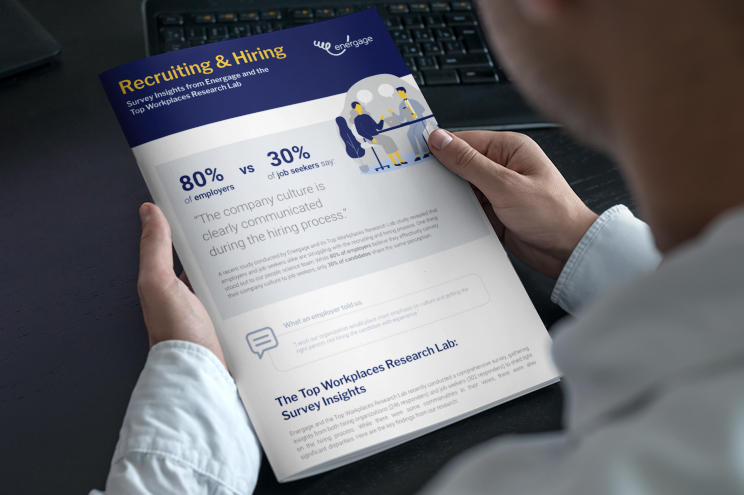What Employee Sentiment Is and Why It Matters
by Energage
Let’s explore employee sentiment, a vital aspect of understanding how your team feels about their workplace. It goes beyond engagement numbers to identify the authentic emotions and perceptions driving employee experiences.
By tapping into employee sentiment, you gain invaluable insights into their perspectives, from benefits and policies to leadership effectiveness and workplace culture. This deeper understanding empowers human resources professionals and organizational leaders to create a more positive and supportive employee experience, ultimately fostering a workplace where everyone feels valued, motivated, and ready to thrive.
Understanding employee sentiment is like shining a spotlight on the heartbeat of your organization. In this post, we’ll dive into employee sentiment, exploring its significance and how it can empower your organization to create a workplace where folks feel valued, engaged, and motivated to succeed.
Why is employee sentiment important?
Employee sentiment is a powerful indicator of an organization’s health and well-being. By gauging how employees feel about their workplace experience, organizations can gain valuable insights into the factors that influence workplace productivity, improve company culture, and enhance employee well-being. It’s like having a window into your workforce’s collective state of mind.
When employees feel valued, supported, and engaged, they’re more likely to be productive and motivated in their roles. Conversely, a lack of employee engagement or satisfaction can lead to decreased productivity, higher turnover rates, and a negative impact on company culture. By regularly assessing employee sentiment, organizations can identify areas of concern and take proactive steps to address them, ultimately fostering a more positive and productive work environment.
Employee sentiment plays a crucial role in shaping an organization’s voice strategy. Employees’ feelings about their workplace experience can directly influence their willingness to advocate for the company, provide feedback, and contribute to its success. Positive employee sentiment can fuel a culture of open communication and collaboration, while negative sentiment may hinder employee engagement and participation in company initiatives.
Employee sentiment is important because it:
- Provides employee satisfaction and engagement insights.
- Identifies opportunities to improve your workplace culture.
- Predicts employee turnover and retention rates.
- Measures employee productivity and motivation levels.
- Helps to shape your organization’s reputation and employer brand.
- Informs the decision-making processes related to HR policies and practices.
- Fosters a culture of transparency and trust within the organization.
What is employee sentiment analysis?
Employee sentiment analysis involves collecting and analyzing employee feedback to measure opinions and emotions about the workplace experience. The process can utilize several tools and methodologies, including surveys, interviews, and sentiment analysis software. By aggregating and analyzing this data, your organization can measure employee sentiment and identify patterns and trends.
You can gain valuable insights into the factors influencing employee attitudes and behaviors, such as job satisfaction and morale, through sentiment analysis. You can also track changes over time, benchmark against industry standards, and pinpoint areas for improvement. This data-driven approach enables your organization to make informed decisions and implement targeted strategies to enhance employee engagement, improve company culture, and drive better business outcomes.
What employee sentiment analysis includes
Employee sentiment analysis offers insights into different aspects of the employee experience, ranging from perceptions of leadership to feelings about workplace policies and practices.
Here are some key aspects of employee sentiment analysis:
- Employee brand perception involves assessing whether employees feel proud to be associated with the company and how they view its image in the marketplace. Positive brand perception among employees can enhance morale and loyalty, while negative perceptions can damage employee engagement and retention.
- Workplace experience encompasses the overall employee journey, from recruitment and onboarding to daily work life and offboarding. It involves evaluating factors such as workplace environment, job satisfaction, and opportunities for growth and advancement.
- Leadership effectiveness focuses on employees’ perceptions of organizational leaders, including senior management, supervisors, and team leaders. It involves assessing leadership communication, decision-making, and ability to inspire and motivate employees.
- Employee recognition involves acknowledging and rewarding employees for their contributions and achievements. It includes formal recognition programs as well as informal gestures of appreciation.
- Training and development: focuses on the organization’s commitment to employee growth and learning. It involves assessing the availability of training opportunities, career development programs, and support for skill enhancement.
How to measure employee sentiment
Measuring employee sentiment includes employee surveys, which provide a structured method for collecting feedback. They are the best way to gather valuable insights into employee perceptions, attitudes, and experiences. Credible methods of measuring employee sentiment include:
- Open-ended questions: Allows employees to provide detailed feedback and express their thoughts. This qualitative data can offer deeper insights into employee sentiment and highlight areas for improvement.
- Confidentiality: Encourages employees to provide honest feedback without fear of repercussions. Confidential surveys create a safe space for employees to voice their opinions and concerns, resulting in more accurate and insightful survey responses.
- Likert scales: Rates employees’ feelings and opinions about the workplace experience. This approach offers a way for employees to express the intensity of their sentiments, leading to richer data for analysis and interpretation.
- Regular cadences: Allows organizations to track changes in employee sentiment over time and assess the effectiveness of interventions or initiatives. Timely surveys ensure that feedback is relevant and actionable, enabling organizations to address issues promptly and proactively.
By following these best practices, organizations can effectively leverage surveys to measure employee sentiment, gain valuable insights, and drive meaningful improvements in the workplace.
Employee sentiment vs. employee engagement
While related, employee sentiment and employee engagement are distinct concepts offering different perspectives on the workplace experience.
Employee sentiment refers to employees’ overall attitudes, emotions, and perceptions toward their workplace environment, leadership, and organizational policies. It provides insights into how employees feel about various aspects of their job and workplace experience, offering a snapshot of their overall mood and satisfaction.
Employee engagement focuses on employees’ commitment, motivation, and advocacy. It reflects the extent to which employees are emotionally invested in their roles, actively contribute to organizational goals, and are willing to give discretionary effort to support the company’s success. While employee sentiment provides a broad understanding of employee feelings, employee engagement measures the depth of their connection and dedication to their work.
Importantly, employee sentiment can help inform and predict employee engagement. By understanding how employees feel about their workplace experience, your organization can identify factors that may influence their level of engagement, such as job satisfaction, morale, and perceptions of leadership effectiveness. Addressing concerns raised by employee sentiment analysis can help improve employee engagement, creating a more positive and productive work environment.
Measure employee sentiment today
Now that you understand employee sentiment, take the next step! The research-backed Energage Workplace Survey is the industry’s most trusted employee engagement survey. It’s the same survey that powers the nation’s Top Workplaces program. See how your workplace measures up, uncover your workplace culture strengths, and get data-driven actionable insights for improvement.



